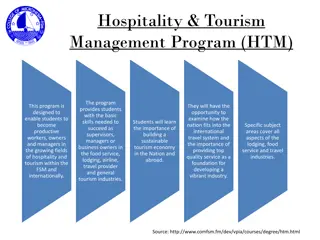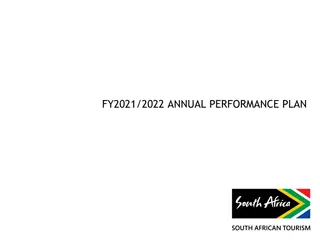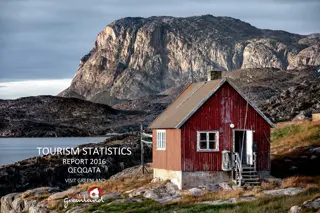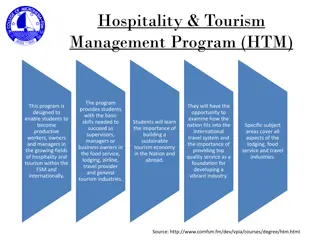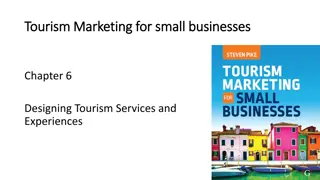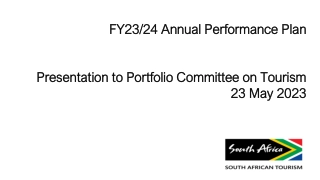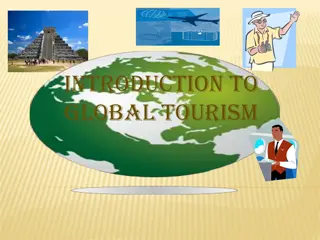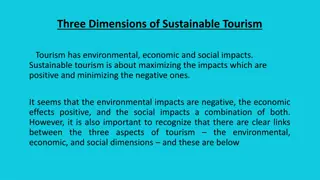Insights into Travel Patterns and Tourism Trends
Explore international and regional travel trends such as visitor arrivals, tourism receipts, and top destinations. Understand the significance of tourism growth, both domestic and international, and learn about the world's top tourism destinations and expenditures. Delve into topics like tourism surplus and deficit to grasp the economic impact of tourism on different countries.
Download Presentation

Please find below an Image/Link to download the presentation.
The content on the website is provided AS IS for your information and personal use only. It may not be sold, licensed, or shared on other websites without obtaining consent from the author. Download presentation by click this link. If you encounter any issues during the download, it is possible that the publisher has removed the file from their server.
E N D
Presentation Transcript
Travel Patterns and Trends (chapter 2)
Introduction International and regional travel trends such as 1. visitor arrivals 2. tourism receipts (amount of $ spent by tourists in a given country during specific time period.) 3. top destinations
Introduction The understanding of trends is important as they provide an indication to what is likely to occur in the future for planning and marketing a touristic destination. External factors including: political demographic, social and technological changes will also be considered.
Tourism Growth Domestic & International Tourism INTERNATIONAL vs. DOMESTIC TOURISM TRENDS Domestic tourism dominates in some countries because of geographical reasons. International tourism dominates in some countries because the location of a country is more conducive to trips outside of the country
The WTO estimates that the scale of world domestic tourism far exceeds that of world international tourism. In 1995... Total domestic tourist arrivals Total international tourist arrivals 5.6 billion 567 million
World's Top Destinations Top Tourism Destinations: France United States Spain Italy United Kingdom Top Tourism Receipts: United States France Italy Spain United Kingdom
Tourism Generators and Expenditures 1.Tourism generators- a category of information on outbound and inbound tourists 2. tourism expenditures - amount of $ spent by tourists for travel experiences. 3. International Tourism expenditures- expenditures of outbound visitors in other countries.
Tourism Surplus and Deficit Tourism surplus- a condition that is achieved when foreign visitors spend more $ in a particular country than total spending of a country s own nationals when they travel abroad. Tourism deficit- a condition that occurs when total expenditures spent in a foreign countries from a given country exceeds the total tourism receipts earned by foreign inbound tourists.
Tourism Growth Total International Arrivals The Boom in international tourist arrivals around the globe is relatively new. Statistics & projects: 1950 1970 2000 2020 25 million people 160 million people 702 million people 1.600 million people
Tourism Growth Top 15 Tourism Destination in 2001 Rank Destinations Number of Arrivals Share 1 2 3 4 5 6 7 8 France Spain United States Italy China United Kingdom 23 million people Russan Fed. Mexico 77 million people 49 million people 45 million people 41 million people 33 million people 11% 7,1% 6,6% 5,6% 4,8% 3,3% 3% 2,9% 22 million people 20 million people
Tourism Growth Top 15 Tourism Destination in 2001 Rank Destinations Number of Arrivals 19 million people 18 million people 18 million people 15 million people 15 million people 13 million people 13 million people Share 9 10 11 12 13 14 15 Canada Austria Germany Hungary Poland Hong Kong Greece 2,8% 2,6% 2,6% 2,2% 2,2% 2% 2%
Tourism Growth Top 15 Tourism Earners in 2001 Rank Destinations Receipts 1 2 3 4 5 6 7 8 United States Spain France Italy China United Kingdom Germany Canada $80.7 $36.7 $33.5 $29.0 $19.9 $19.0 $18.0 $19.9
Tourism Growth Top 15 Tourism Earners in 2001 Rank Destinations Receipts 09 10 11 12 13 14 15 Austria Greece Australia Mexico Turkey Switzerland Singapore $15.0 $12.0 $11.0 $11.0 $9.0 $9.0 $9.0
Tourism Growth Top 15 Tourism Spenders in 2001 Rank Destinations Expenditure 1 2 3 4 5 6 7 8 United States Germany United Kingdom 35 US$ Billion Japan France Italy China Netherland 70 US$ Billion 45 US$ Billion 30 US$ Billion 17 US$ Billion 15 US$ Billion 13 US$ Billion 12 US$ Billion
Tourism Growth Top 15 Tourism Spenders in 2001 Rank Destinations Expenditure 09 10 11 12 13 14 15 Canada Belgium Austria Korea Sweeden Switzerland Taiwan 12 US$ Billion 10 US$ Billion 9 US$ Billion 7 US$ Billion 7 US$ Billion 7 US$ Billion 6 US$ Billion
Tourism Growth Average Number of Vacations (2001) Italy France Germany Brazil UK Canada Korea Japan USA 42 Days 37 Days 35 Days 34 Days 28 Days 26 Days 25 Days 25 Days 13 Days
Regional Travel Patterns & Trends International Arrivals by Region Forecast Region 1995 2000 2010 Annual Growth Europe 337 84 112 19 11 4 567 400 115 120 28 23 6 692 525 229 195 37 26 11 1.023 3.1% 7.6% 3.7% 4.6% 4.9% 6.7% 4.1% East Asia/Pacific Americas Africa Middle East South Asia World (in Millions)
Regional Travel Patterns & Trends Europe As a region, Europe is the world s number one destination. In 1995, the region attracted two-thirds of all international tourist arrivals. It is also the leader in intra-regional travel: it is estimated that 80% of the visitors to Europe are other Europeans.
Regional Travel Patterns & Trends Europe Leading destinations are: France, Spain, Italy However there is a decrease in the growth rates of foreign arrivals, attributed to saturation levels and poor exchange rates. As a sub-region within Europe, the Eastern Mediterranean countries, such as Turkey and Israel and central European sub-region will be in increase of arrival growth rate.
Regional Travel Patterns & Trends Asia and the Pacific The growth of travel in East Asia and the Pacific has been particularly rapid. From a region with arrivals totaling fewer than 100.000 in 1950, 7.2 million in 1970, 88 million international arrivals in 1995. The forecast shows East Asia and the Pacific moving ahead of the Americas, ranking second in 2010.
Regional Travel Patterns & Trends Asia and the Pacific Top destinations include China, Hong Kong, Singapore. Indonesia, Malaysia, Cambodia and Vietnam will continue to grow as well. China has the potential to be a particularly rich source of outbound travelers, with its rapidly expanding economy. Travel in mostly by air and sea (expensive form of travel) Travel focus on social and cultural discoveries Less restriction on travel among countries in the same region Countries share some common cultural and social characteristics
Regional Travel Patterns & Trends South Asia South Asia region has made impressive development in recent years, starting at a smaller base. The region is compromised of India (top destination), Sri Lanka, Maldives (based on its beach resorts), Nepal (which offers special interest tourism), ran, Bangladesh. Since 1993, the regional growth rate was three times higher than the world average. Increase in travel due to better air transportation access and increase international trade in the region
Regional Travel Patterns & Trends Americas The USA and Canada, like western Europe have reached their peak, meaning that growth for outbound tourism will slow. Intra-regional tourism dominates: In 1995, 75% of total arrivals were intra regional tourist flows. Cuba & Mexico experienced the quickest growth rate of all the countries of the Americas. Cheaper modes of transportation
Regional Travel Patterns & Trends Middle East The Middle East was the fastest growing region for 1995. Top destinations include Egypt (top destination), Jordan, Bahrain and Lebanon. Rapid growth was explained by a renewed interest in cultural tourism and an increase of political stability in the region.
Regional Travel Patterns & Trends Africa Africa is a problematic tourist destination: political instability, military disturbances, health apprehension have discouraged travelers. One exception: South Africa enjoyed growth in both leisure and travel business. For the future, Africa needs improving political stability.
External Factors Changing demographics Mostly young travelers Travel by retirees/senior citizens Increase in family market travelers
Technological Advances Transportation Internet/Computerized Reservation System
Political Changes China and Russia open their doors to World Tourism Establish demographic government and free market economies
Demand for sustainable Tourism Environment Sustainable Tourism- the ability of a destination to remain completive against newer, less explored destinations; to attract first time visitors as well as repeaters; to remain culturally unique and be in balance with the environment Limitation on infrastructure development (environment protection) Eco tourism Creation of organizations geared toward protection and conservation of natural resources
Safety/Security and Health Disease Crime Threat of international conflicts Aviation Safety











